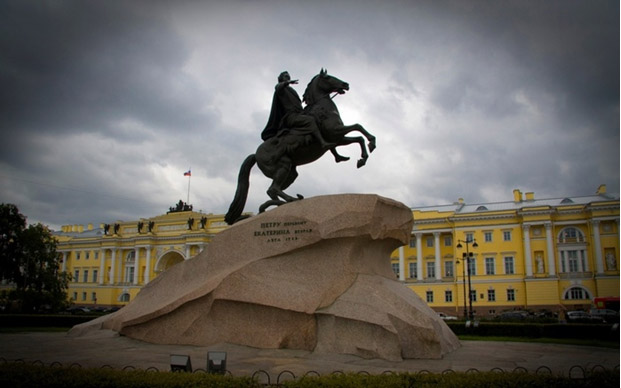1700 year historical flags of the states. Interesting online
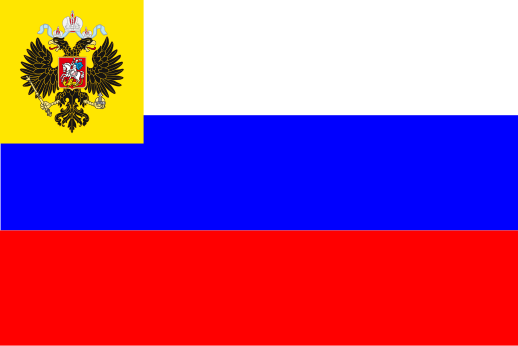
Chronicle of Russian flags
From time immemorial, vast territories of Eastern and Central Europe were inhabited by Slavic tribes. The ancient chronicles and chronicles call the Slavs a brave, militant and freedom-loving people. By the 9th century Slavic princedoms were formed. Their centers were Pskov, Polotsk, Smolensk, Chernihiv, Pereyaslavl, and others. Novgorod and Kiev were considered the largest cities. At that time, there was still no single Slavic state, and, naturally, one should not look for a single state flag. Preserved mention of the first Russian flags, or, as they were called, flags. The rod means a lever, as well as a pole, pole, pole. And indeed, the oldest Russian banners were long poles, on the tops of which tree branches, tufts of grass, horse tails, the so-called banner bangs, were strengthened. Later, on the banners began to attach pieces of fabric of bright color, giving them a wedge shape. Often the fabric was attached not to the pole, but to a small crossbar. The pole ended with a pinnacle - ostrozhek.
At the end of the 9th century, Prince Oleg of Novgorod seized Kiev and remained here to reign, declaring the city the capital “the mother of Russian cities”. Kievan Rus for the first time united the Slavic principalities from the Baltic to the Black Sea, from the Carpathians to the Don, became the historical cradle of the Russian, Ukrainian and Belarusian peoples. The flag of the state was not yet. There were only princely banners. They were revered. Without a banner, the army did not go on campaigns and did not enter battle. Princely banners usually had an almost square panel with kositsami - klintsami, yalovetsy. In 907, Prince Oleg reached with Byzantine forces and nailed the “shield on the gates of Constantinople”. With the introduction of Christianity in Russia, after 988, images of the cross appeared on Russian banners. This symbol was widely distributed in other European countries. Banners acquired the value of the shrine.
Under Yaroslav the Wise, at the beginning of the XI century, Kievan Rus united vast lands, reached great prosperity and became one of the largest states in Europe. Descriptions of the banner of Yaroslav the Wise have not been preserved, but one can say that the main symbol of Russia is connected with his name - the image of St. George, which later took the place of honor on the emblem of Russia, and on the standard of its kings. The name Yaroslav was secular, princely, pagan, and the prince was baptized by the name of George. According to Christian custom, the patron saint of the prince after baptism became St. George Since Yaroslav the Wise was considered the first unifier of "All Russia", his "patron" - St. George the Victorious - began to be considered the patron saint of the entire Russian state.
The unification of Russia was not yet solid, and after the death of Yaroslav, the power was fragmented - divided among his sons by inheritance. The feud began. Prince Vladimir Monomakh, who ruled from 1113 to 1125, managed only for a while to restore the unity of Kievan Rus, but after his death, the state was again broken up into separate principalities.
The nomadic Polovtsy became the terrible enemy of the Slavs. The feudal princes, under their banners, marched against the enemy. The greatest monument of ancient Russian literature, The Word about Igor's Regiment, tells about one of these trips. The manuscript mentions that at the head of the prince’s warriors in 1185 were “Chrlen, White Belief, Cholka,” ie, red banner, white banner, red bangs. Grand Prince Andrei Bogolyubsky moved the capital of Russia to his city of Vladimir. There were banners of the great princes. The princely and princely banners of ancient Russia were huge, up to 8 arshin (6 meters) in length, and heavy. In the styagovniki picked heroes. During the campaigns, banners removed from the pole were in a wagon train along with armor and weapons. Only before the battle was given the command "to take a weapon, put on armor and hoist banners." Typically, the banners installed in the center of the troops on the dais. During the battle, the attackers sought to break through to the banner, "cut it" and capture it. In most cases this decided the outcome of the battle. That is why the banner was constantly in the center of attention of all the fighters, and the chroniclers of the battles personified the course of the battle as a banner. When, for example, they wrote that “the banner stretched like clouds”, the battle developed favorably, “the padosha of the banner” - the battle was lost.
The prince's rati was not alone. The army was divided into shelves: a large, right hand, left hand, watchmen. At the head of a large regiment, the great prince was exhibited, and in the other regiments — a smaller banner. Each princely squad of inheritance, as well as ratios of regions and cities had their banners. So, for example, in 1216, Prince George of Suzdal put up 17 banners in the Lipitskoy battle, and Yaroslav - 13. Feudal fragmentation and civil strife weakened Russia, and in the XIII century, Genghis Khan’s Tatar-Mongol hordes invaded its lands from the south and east, and then Khan Batu. It was a difficult period for Russia. From the north the Russian lands were attacked by the troops of the Swedish and German feudal lords. July 15, 1240 squads under the banner of the Novgorod Prince Alexander defeated the Swedes on the banks of the Neva. Prince Alexander was nicknamed Nevsky. And on April 5, 1242, the Ice Battle on the ice of Lake Peipsi occurred. The army of Prince Alexander Nevsky defeated the knights of the Livonian Order.
The defeat of the Swedes and the Germans contributed to the restoration of the unity of Russia. Although the city of Vladimir remained the capital, the influence of Moscow, founded by Prince Yuri Dolgoruky in 1147, was rapidly growing. The unification of the Russian lands around Moscow began. The Tatar-Mongolian conquerors sought to prevent the unification. Khan Mamai with a huge army invaded the borders of the Moscow principality. He was met by Moscow Prince Dmitry, fighting squads. On September 8, 1380, the Russians and Tatars converged on the Kulikovo Field beyond the Don. On the hill in the Mamaia camp, Tatar towers rose, in the center of the Russian troops - the grand duke's. In the most ancient document “The Behavior and the Tale of the Battle of the Grand Duke Dmitry Donskoy” there are such lines: “The Prince Dmitry Veliky Ivanovich, seeing his regiments adequately ouryazheny, lost heart, and fell off his horse, fell on his knee directly to the great regiment and the black sign on the image of our Lord Jesus Christ is imagined in him. ” This banner is first called a sign, unlike other banners without the face of Christ. It should be recognized that the question of the color of Dmitry Donskoy’s banner is not indisputable. In some manuscripts it is listed as “cherny” - red, in others - as black, but many researchers consider this a slip of tongue. Red color was widespread in Russia, which is not the case with black. However, the ascetic beginnings of ancient Russian painting allow us to think that the people with whom they went to battle for the “terrible judgment of God” were severe, menacing, black.
Before the start of the battle, Dmitry ordered his neighbor boyar Mikhail Brenk to stand under the grand duke's banner. The chronicler writes that it was strange to see "two great forces converging on bloodshed, to die soon." The bogatyr Chelubey left the Tatar hordes, the Russian bogatyr Peresvet came out against him. In a deadly battle, both warriors fell dead. A fierce and bloody battle began. “Tatarov, however, began to overcome the great prince of the Grand Duke, podkosha,” brave Brenok and many fighters of his team fell under him. But the Russians did not give up. A fresh regiment of Bobrok came out of the ambush. Tatars fluttered and ran. The great battle was won by the Russians. But dearly this victory was given. Only a few returned to the banner - only forty thousand of four hundred thousand Russians survived. Tatar was killed a great many. "The Don River flowed three days in blood, buried the dead for eight days ..."
After the Kulikovo battle, banners with the image of the face of Christ - signs - became widespread. In the XV century, the word “banner” came into use, in the XVI century, banners and flags were also mentioned, by the XVII century the word “banner” is encountered less and less and finally replaced by the word “banner”. In the XV-XVI centuries under Ivan III and Vasily III great Russia was united under the "high hand of Moscow." Ivan III became known in acts as the “Odopodar of All Russia”, and Vasily III was already called the “Tsar and Sovereign of All Russia”. The Russian state grew rapidly and strengthened. Amazed Europe, at the beginning of the reign of Ivan III, was hardly even suspected of the existence of Muscovy, squeezed between Lithuania and the Tatars, was stunned by the sudden appearance of a huge empire on its eastern borders. ”
In the XVI century on the Russian banner embroidered faces of Christ and the Virgin, the image of St. George the Victorious. On the white banner of Basil III was an image of Joshua, stopping the sun. Preserved regimental banners. At the head of the regiment now stood the great Tsar's banner. In the hundreds were smaller banners.
Under Ivan III, a symbol of a double-headed eagle appeared in Russia, which later became the emblem of Russia. The double-headed eagle has long been the emblem of the Roman Empire. After the collapse of the empire, Byzantium became its successor, retaining a double-headed eagle in its coat of arms. In 1497, the marriage of Ivan III with the Byzantine princess Zoya Paleolog, better known as Sophia, took place. The Moscow grand dukes, as it were, became the heirs of the Christian Byzantium and received as a gift the Byzantine throne with the image of a two-headed eagle. So the two-headed eagle became the emblem of Russia.
The Russian flags of that time were crooked, that is, on the one hand one or several oblique wedges were sewn on. The rectangular part of the panel was called the middle, its length was greater than the height; a right triangle — a slope — was sewn to the cloth with its short side, bowstring down. Often the banner was trimmed with a border or fringe. The images on the banners kept a religious character. Cloths remained of enormous size, and two or three people were appointed to carry the banner. Banners were given great honors, they were consecrated by the patriarch after the rank of holy icons. In 1547, Ivan IV was crowned to the throne as the "Tsar of All Russia." This title was minted on Moscow money, and they received the value of All-Russian. However, the autocratic Russian state has not yet had a single state flag. The princes had their banners, the king - his banner. The banner had not yet become a symbol of the state, but remained a symbol of personal power.
In form, some of the grand-ducal banners to 988 AD were three-legged or with a three-stage notch at the end, to which brushes were sewn at the end. This form of banners along with the “bident”, the emblem of the Grand Duke Svyatoslav, was drawn on the Arab dirhams of the 10th century, which was circulated on the territory Ancient RussiaRussian coarse with "Binary". X century
Scarlet XII century.
Judging by the pictures of the chronicles and the text "Words about Igor's regiment" in the XI-XII centuries in Russia there were mostly triangular banners of predominantly red color, although there are yellow, green, white, black banners. Sometimes there was a special pommel (crescent or other), a bang and a drawing on the banner.
The Russian society did not accept this new symbol of state power: in the minds of Russians, black and yellow colors were associated with Austria and the Hapsburg home ruling there. In the empire, in parallel, there were two flags: black-yellow-white - the national "de jure" and white-blue-red - the national "de facto", with the first flag not widely spread, and the preferences of the population were everywhere given to the latter.
Emperor Alexander III, known for his Russophile sentiments, drew attention to the contrast during the coronation in Moscow: the Kremlin was decorated and the whole procession was dressed in black, yellow and white, and in the city white, blue and red colors prevailed. A commission of authorities was appointed under the chairmanship of the Adjutant General Admiral K. N. Posiet. The commission made the following decision: “The white-blue-red flag, established by the emperor Peter the Great, is almost 200 years old. Heraldic data is also noticed in it: the Moscow coat of arms depicts a white horseman in a blue raincoat on a red field. These colors are confirmed by the flags in the navy: the 1st line is indicated by red, the 2nd by blue and the 3rd by the white flag with St. Andrew's cross in the roof. The counter- and vice-admiral flags, respectively, have red and blue stripes, and finally, the guis is made up of colors: white, blue, and red. On the other hand, white-yellow-black colors have neither historical nor heraldic bases behind them. ” Based on the decision of the commission of Admiral Posyet, the national flag was the highest approved white-blue-red. According to other data, the Minister of the Interior, Count D. A. Tolstoy, had previously presented the king with two flags: black-yellow-white as national, and white-blue-red as trade. But the emperor ordered the use of a uniform flag.
Coronation standard of Nicholas II. Late XIX century.
It finally became national in 1896. Black, yellow and white remained only in the imperial family.
On April 29, 1896, Nicholas II ordered to declare now that the white-blue-red flag should not be honored in all cases, and the other flags should not be allowed.

Flag 1914
With the beginning of the First World War in 1914, an additional circular was introduced to raise the patriotism of the population by a special circular of the Ministry of Foreign Affairs. imperial flag "For use in private life." It differed from the national flag of the empire in a yellow square with a black double-headed eagle (composition corresponding to the emperor's palace standard). The eagle was depicted without title emblems on the wings, the square overlapped the white and about a quarter of the blue flag strip. However, this flag did not receive distribution; contrary to popular misconception, it was never the national flag of the Russian Empire. The new flag was not introduced as mandatory, its use is only "allowed". Symbols of the flag emphasized the king's unity with the people.
Standard of the President Russian Federation (since 1994).
Flag of the Supreme Commander of the Armed Forces of the Russian Federation.
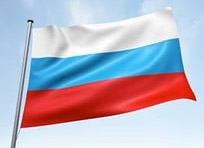 Flag
- a panel of regular geometric (most often, rectangular) shape, having any special coloring or patterns and attached to a flagpole. Flags in large quantities are produced at special state-owned enterprises and distributed through the country's trade network.
Flag
- a panel of regular geometric (most often, rectangular) shape, having any special coloring or patterns and attached to a flagpole. Flags in large quantities are produced at special state-owned enterprises and distributed through the country's trade network.
The flag, as well as the coat of arms, is one of the state symbols reflecting the country's history, its international position and significance. The duty of every citizen is to protect the national flag from encroachments and insults from the enemies and detractors of his country.
It is known that flags have not only states, but also individual regions and cities; and international organizations (such as the UN flag), commercial companies, national movements and diasporas, social movements (such as the pacifist flag), and even sports teams.
In addition to the state, many countries have naval and commercial (commercial) flags. With the help of flags you can also transmit signals. In 1857, ships of all countries began to use a single international system of signal flags.
So, yellow flag means that there is an epidemic on board the ship and the crew is in quarantine. Another well-known symbol is white flagwhich during war means truce or surrender. A half-flat flag symbolizes mourning for some tragic event.
Usually, the flag rises on a special mast-flagship. Vexillology is engaged in the study of flags (from Lat. Vexillum - “banner”, “flag”).
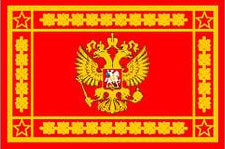 Banner
- This is a single flag product, which, as a rule, is made of expensive materials and richly decorated with ribbons, embroidery, fringe, tassels. The cloth itself is sewn from two rectangular pieces of fabric connected along the perimeter. The banner is fixed directly to the shaft with the help of special flag nails.
Banner
- This is a single flag product, which, as a rule, is made of expensive materials and richly decorated with ribbons, embroidery, fringe, tassels. The cloth itself is sewn from two rectangular pieces of fabric connected along the perimeter. The banner is fixed directly to the shaft with the help of special flag nails.
Another difference between the flag and the flag is the presence of a pointed tip. The banner is a military banner, under which faithful soldiers are united. Battle flag military unit - its official symbol and military relic, it personifies its honor, valor, glory and military traditions, indicates the purpose of the military unit and its identity.
Our country currently has the State banners of the Russian Republic and the Russian Army, as well as army, regimental banners (standards in the cavalry regiments) and troops (from the Cossack troops). The loss of a military banner in battle is considered a great shame.
A special relic is the Victory Banner, carried by the Red Army across all fronts of the Great Patriotic war and hoisted on May 9, 1945 over the Reichstag of Nazi Germany.
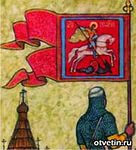 Banner
- This was the name of the military banner in Ancient Russia, which was a pole with a “bang” attached to its upper end - a bundle of horsehair, a wedge of bright fabric or a totem animal.
Banner
- This was the name of the military banner in Ancient Russia, which was a pole with a “bang” attached to its upper end - a bundle of horsehair, a wedge of bright fabric or a totem animal.
Later, the “fringe” was replaced by a large wedge-shaped canvas of bright fabric, onto which the image of the Life-Creating Cross was sewn. The ends of the banners could have two or three "tails", which were called "kositsy", "klintsami" or "yalovets". In peacetime, the church services were held under the banner, the troops took the oath, international treaties were concluded.
During the campaigns, the flag was removed from the pole and transported in a train along with weapons and armor under the protection of special soldiers. The flag was put on the pole before the battle. The banners were usually huge and took a long time to stage. Hence, the expression “not having put up any banners”, which meant a sudden attack by the enemy (“to be caught unawares”). And the expression "to put a banner" was understood as a declaration of war.
During the battle, mounted in the center of the army, on a hill. His fall caused panic or confusion, so during the battle, the banners were guarded especially carefully. The enemy threw his main forces at the seizure of the enemy, and the hottest fights usually took place under the banners. The chroniclers report: if “the plaits of a banner stretch like clouds”, then the Russian troops win; if the "podsekosh" flag, or "the prince's banners fell," it means that the battle ends in defeat.
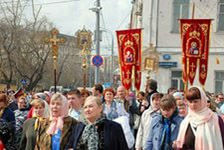 Banner
- The sacred banner of the church, which, along with the cross, is used in the days of very solemn celebrations, for example, during the procession. In normal times, the banners are in the temple near the altar.
Banner
- The sacred banner of the church, which, along with the cross, is used in the days of very solemn celebrations, for example, during the procession. In normal times, the banners are in the temple near the altar.
Holy banners mean the victory of the Christian church over the world. The first church banners of the modern type appeared in the Roman Empire under the emperor Constantine the Great, who commanded to decorate his banner with the cross. Nowadays, banners are decorated with the faces of saints or illustrations from the Holy Scriptures.
For some time, khorugvi were used in ancient Russia as military banners. On them were embroidered the faces of the Savior, the Virgin, the saints, as well as the princely coat of arms or holy relics. In tsarist Russia, khorugvi were long preserved in the Cossack troops, where their carrier was a special officer — a cornet.
Bunchuk - among the nomadic peoples there is a hollow inside and therefore a very light shaft with a horse or yak's tail tied to it, which served as a sign of power. In Eastern Europe, the first bunchuks appeared in the 13th century, shortly after the Tatar-Mongol invasion.
As a tip at the top of the bunch, a metal ball or crescent was often hardened. Horsehair was dyed blue, black and red, and the shaft itself was decorated with oriental ornaments.
PART ONE
FIRST FLAGS IN THE HISTORY OF HUMANITY
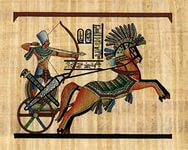 "At all times in different countriesah and the lands there were certain signs and symbols with the help of which people communicated with each other, showed which tribe or people they belonged to. One of these signs is the flag. From ancient times to the present day, it has been considered a symbol of an independent state or nation. No wonder the rise of the national flag is the first solemn ceremony after the proclamation of a new state.
"At all times in different countriesah and the lands there were certain signs and symbols with the help of which people communicated with each other, showed which tribe or people they belonged to. One of these signs is the flag. From ancient times to the present day, it has been considered a symbol of an independent state or nation. No wonder the rise of the national flag is the first solemn ceremony after the proclamation of a new state.
The flag has always symbolized national honor. When the war began, the men became “under the banner” and took the oath of allegiance to their country. To be a standard-bearer in battle was considered very honorable, and to capture an enemy banner meant to accomplish a real feat. And if the banner was in the hands of the enemy, the shame fell on the entire army.
The national flag as a shrine is given the highest state honors. His dignity is defended domestically and abroad, his insult is seen as an insult to the honor of the state and the nation.
The history of modern banners and flags has its roots in antiquity. As historians believe, it began more than 30 thousand years ago with rock paintings of animals. Our ancestors painted various animals and birds in their caves, because they honored them as their intercessors, and perhaps in this way they prayed the gods to send them good luck on the hunt.
Later, some families and tribes began to use images of certain animals as generic symbols - totems. They were painted on the walls of caves, above the entrance to the dwelling, or carved out of wood and stone. Men took these symbols with them to the war, often strengthening them at the end of a long pole.
Totems not only promised help and protection of their ancestors, but also had practical significance: if a warrior was pushed aside from his fellow tribesmen during a battle, he found them on the battlefield along a highly raised pole with a figure.
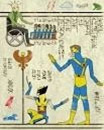 From primitive times, this custom reached the most ancient civilizations of the Earth. About 5 thousand years ago in ancient Egypt one of the totems was a falcon, later it began to personify the god of the sun and the sky of Horus, the patron saint of the Egyptian kings - the pharaohs. The Egyptians believed that the Pharaoh is the embodiment of God - the falcon Mountain. Therefore, the Egyptian warriors carried long poles with special badges, symbols of their troops, the top of which was crowned with a figure of a divine bird.
From primitive times, this custom reached the most ancient civilizations of the Earth. About 5 thousand years ago in ancient Egypt one of the totems was a falcon, later it began to personify the god of the sun and the sky of Horus, the patron saint of the Egyptian kings - the pharaohs. The Egyptians believed that the Pharaoh is the embodiment of God - the falcon Mountain. Therefore, the Egyptian warriors carried long poles with special badges, symbols of their troops, the top of which was crowned with a figure of a divine bird.
Later, the pharaohs ordered only a few falcon feathers to be attached to the poles instead; then to the feathers, to make it more noticeable, they added a long ribbon, which fluttered in the wind. Probably, such a sign no longer had religious significance, but was supposed to help the commander identify his troops during the battle. During military campaigns, standard-bearers carried flags on long poles. With these flags it was possible to determine how many soldiers each military leader has. In addition, the flags looked beautiful.
Soon, such signs began to be applied everywhere. For example, Assyrian warriors at the end of a long pole reinforced a disk with a picture of a bull or two horned oxen. And among the ancient Greeks, some animals traditionally denoted any nation or state: the owl was a symbol of Athens, the galloping horse — Corinth, the bull — Boeotia.
 The Greeks adopted this custom by the Romans. Signals of the Roman legion were called to signum — they tied animals' tails, bundles of hay, attached various metal badges. In 104 g. er Consul Marius ruled that the image of the eagle would now be the sign of the Roman legion. The eagle had previously been a totem among the peoples of Asia, from whom the ancient Persians and Greeks had apparently adopted it, and the Romans had already adopted it from them.
The Greeks adopted this custom by the Romans. Signals of the Roman legion were called to signum — they tied animals' tails, bundles of hay, attached various metal badges. In 104 g. er Consul Marius ruled that the image of the eagle would now be the sign of the Roman legion. The eagle had previously been a totem among the peoples of Asia, from whom the ancient Persians and Greeks had apparently adopted it, and the Romans had already adopted it from them.
About 100, under the emperor Trajan, banners were introduced according to the Parthian or Dacian pattern in the form of dragons made of dyed fabric. The dragonlike banners of the emperors, who carried in battles and at festive parades, were sewn of purple matter. ” This is how the Russian historian, journalist, researcher of the Moscow Institute for Strategic Studies Konstantin Alexandrovich Zalessky (born 1965) describes the history of the appearance of the first flags of the ancient peoples of the Earth.
The first prototypes of European flags were Roman signs - poles with metal images put on them, which served as special insignia for each military unit of the Roman army.
These insignia consisted of a symbol - a bird, a dragon, an image of the emperor, etc. They were made of copper, and were worn by special warriors - signifers. According to K.A. Zalessky, gradually all these symbols were canceled and the eagle was left a sign of the Roman legion, the image of which became mandatory for each cohort of soldiers.
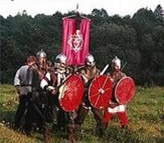 At first, there were no linen banners in the ancient Roman army. However, in the last centuries of Roman history, the so-called vexillum - long poles, on the upper cross bar of which a freely hanging purple quadrangular panel was fastened, which is considered to be the first Western European flag.
At first, there were no linen banners in the ancient Roman army. However, in the last centuries of Roman history, the so-called vexillum - long poles, on the upper cross bar of which a freely hanging purple quadrangular panel was fastened, which is considered to be the first Western European flag.
The Vecsillums were declared a symbol of imperial power. Purple was considered in Rome as the color of the emperor and his military officers. From the name of Veksillum came the name of modern science, which studies the history of modern flags of the whole world.
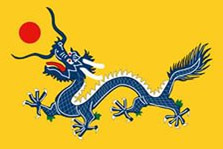 The first flags, similar to our usual banners, appeared in ancient China around 100 BC. These were rectangular silk cloths, which were no longer attached to the crossbar of the pole, but to its very shaft.
The first flags, similar to our usual banners, appeared in ancient China around 100 BC. These were rectangular silk cloths, which were no longer attached to the crossbar of the pole, but to its very shaft.
Silk, then not yet known in Europe, was lighter and more beautiful than a rough cloth of Veksillum. He fluttered on a pole even from a light breeze. Silk cloths were durable and bright, they could be painted and write on them the slogans of the Chinese emperors.
The oldest, preserved to the present day flag panel is considered Shahdad flagwhich is currently stored in the National Museum of Tehran. It was found in 1975 in Kerman, in the east of Iran. According to archaeologists, the flag was made in the 3rd millennium BC in the most ancient region of the country - Shahdad, by which it got its name.
Shahdad flag is a metal plate measuring 22 by 22 centimeters, made of copper alloy with bronze and arsenic. The ancient symbols of Iran are engraved on it, and the flagpole is crowned with a figure of an eagle.
Shahdad flag has its own name - Diravshi Kaviyani. It is associated with an ancient legend, which can be read in the poem of Firdousi - "Shahname". Diravshi Kawiyani appeared during the uprising of the Iranian people against foreign rulers who seized the Iranian throne. The leader of the uprising was a simple blacksmith named Kave, who attached his leather blacksmith’s apron to a spear and under this banner led the people to the storming of the royal citadel.
Thanks to this, the heir of the Iranian Shah, Faridun, was restored to the Iranian throne. He considered the banner of Cave a symbol of good, decorated the leather panel with a four-pointed star, precious stones and ribbons of red, yellow and purple. The flag got its own name and became state symbol Ancient Iran.
PART TWO
FLAGS AND BANNER OF ANCIENT RUSSIA

The earliest mention of the use of flags and flags by ancient peoples, including the ancestors of the Slavs, is preserved in the ancient Iranian collection of sacred texts - "Avesta". Proto-Slavic tribes in ancient times inhabited a vast territory, which included and Asia Minor.
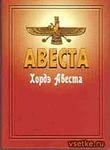 According to legend, “Avesta” is a revelation received by Zarathushtra from Ahur Mazda - the supreme deity of the ancient Iranians. It was recorded in gold ink on 12 thousand ox-skins in the unknown “Avestian dialect”, and then, by order of Alexander the Great, translated into Greek.
According to legend, “Avesta” is a revelation received by Zarathushtra from Ahur Mazda - the supreme deity of the ancient Iranians. It was recorded in gold ink on 12 thousand ox-skins in the unknown “Avestian dialect”, and then, by order of Alexander the Great, translated into Greek.
In the texts of the "Avesta" there are several references to the existence of flags and flags among many peoples of Europe and Asia. Thus, in the first chapter, Bactria is characterized as “a beautiful land with highly raised flags”. Further, some are mentioned some "waving in the wind bullish banners."
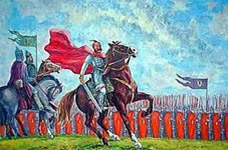 In the 4-7th centuries, during the Great Migration of Nations, our ancestors crossed over to the territory of the Russian Plain, where the system of Slavic tribes formed, which we know from the textbooks of school textbooks.
In the 4-7th centuries, during the Great Migration of Nations, our ancestors crossed over to the territory of the Russian Plain, where the system of Slavic tribes formed, which we know from the textbooks of school textbooks.
The Slavs were active in foreign policy and had a military organization in the form of a prince's squad and foot militia. For the organization of warriors during military clashes with neighboring nations, the princes used military banners.
Today, historians know little about the oldest Slavic flags. Presumably, the first of them was a spear, to the upper end of which were attached horse tails or tufts of grass. These objects towering over the army served as a guide for the warriors of the tribe. They designated the place of gathering of princely detachments and carried out some military tasks during battles or long campaigns.
 AT "Tale of Bygone Years" (12th century) “banners” and “banners” are mentioned, which already represented a panel attached to a pole. Gradually, the Slavs had a special position - a styagovnik. It was the man who guarded the flag in peacetime and carried it in campaigns and battles.
AT "Tale of Bygone Years" (12th century) “banners” and “banners” are mentioned, which already represented a panel attached to a pole. Gradually, the Slavs had a special position - a styagovnik. It was the man who guarded the flag in peacetime and carried it in campaigns and battles.
Over time, the banners began to serve not only as guidelines for the squad and militia, but also turned into special symbols of princely power. Conquering new lands and capturing cities, the princes hoisted their banners over them, which meant the spread of princely power to new territories.
In the 9-13 centuries, the old Russian flags had the shape of an elongated triangle with a fringe sewn on the edges. There were also ensigns with a beveled wedge and border, as well as banners, sheathed with special braids, which fluttered in the wind. Church banners were also used in battles - banners, which depicted the faces of the Savior, the Virgin Mary and Slavic saints.
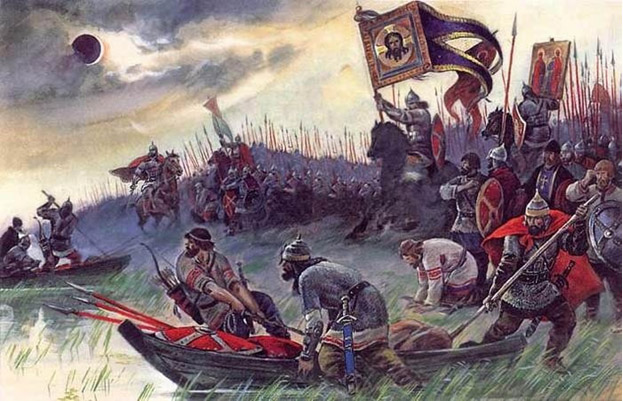
The color of the ancient Russian flags was very diverse - from yellow to black. But most often used green, blue, white, red and blue cloth.
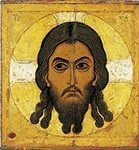 So, during Kulikov battle (1380) princely detachments entered the battlefield under red banners adorned with the image of the Savior, not made by hands. And the famous Black Hundred Sergius of Radonezh fought under black banners and white banners with the image of the Virgin and the saints.
So, during Kulikov battle (1380) princely detachments entered the battlefield under red banners adorned with the image of the Savior, not made by hands. And the famous Black Hundred Sergius of Radonezh fought under black banners and white banners with the image of the Virgin and the saints.
In the famous "The Word of Igor's Regiment" Russian flags of the 12th century are described. Princes go on a campaign against the Polovtsy under the "red banners", "white banners and" red bangs "(bunches). The author of The Word is already using the word “banner” as a symbol of princely power. Narrating about the defeat of the Russian princes in the second battle with the Polovtsy, he bitterly exclaims: "By noon on Friday, the banners of Igor have fallen!"
From the end of the 14th century, all Russian flags began to depict the face of the Savior. Such banners — huge, hand-embroidered cloth — were considered a military shrine and were consecrated in temples. They were called "signs," from which the word "banner" originated. The most common were the banners with the image of the patron saint of Russia - the Savior, not made by hands.
PART THREE
RUSSIAN FLAGS 16-17 centuries

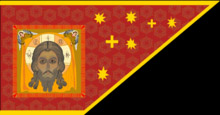 In the 16th century, in addition to the images of the Savior and the Virgin Mary, Russian flags began to embroider the image of St. George. In the reign of Ivan the Terrible, each regiment had to have a large Tsar's Banner, and every hundred - a small wedge-shaped flag. Embroidery on them was made in gold, silver and silk, and the inscriptions - in bright icon paints.
In the 16th century, in addition to the images of the Savior and the Virgin Mary, Russian flags began to embroider the image of St. George. In the reign of Ivan the Terrible, each regiment had to have a large Tsar's Banner, and every hundred - a small wedge-shaped flag. Embroidery on them was made in gold, silver and silk, and the inscriptions - in bright icon paints.
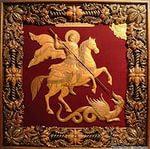 George the Victorious - Christian saint, great martyr, especially revered in orthodox saint. According to the life, he was born in Palestine in the family of Christians (3rd century). He served in the army of Emperor Diocletian, was considered his favorite.
George the Victorious - Christian saint, great martyr, especially revered in orthodox saint. According to the life, he was born in Palestine in the family of Christians (3rd century). He served in the army of Emperor Diocletian, was considered his favorite.
Having received a rich inheritance after the death of his parents, he went to the court, hoping to achieve a high position.
At the beginning of the 4th century in Rome began the persecution of Christians. George, having distributed his property to the poor, before the emperor declared himself a Christian. By order of Diocletian, he was arrested and subjected to cruel torture for eight days, demanding renunciation of the faith. After heavy suffering in 303, George was beheaded. Together with George, the wife of Diocletian, Queen Alexandra, who stood up for the saint, was martyred.
After the execution, George performed several posthumous miracles, the most famous of which was the killing of a dragon with a spear, which devastated the land of Christians. When the lot fell out, the royal daughter came to be torn apart by the serpent, George appeared and pierced the dragon with a spear. The phenomenon of the saint caused the mass conversion of the population of the region to Christianity.
In Russia since ancient times, St. George was worshiped under the name of Yuri or Yegoria. In the 1030s, Yaroslav the Wise founded the monasteries of St. George in Kiev and Novgorod and ordered to create the Feast of St. George on 26 November (9 December in a new style) throughout Russia.
In the Russian lands, George was perceived as the patron saint of warriors, farmers and herders. The days of April 23 and November 26 in our country are considered spring and autumn St. George days.
Since the time of Dmitry Donskoy (14th century), St. George the Victorious is known as the patron saint of Moscow, since the Russian capital was founded by the eponymous holy prince, Yuri Dolgoruky. In 1730, the Moscow coat of arms with the image of George was formalized.
Currently, the image of the saint is also present on the Russian coat of arms. He describes how “a silver rider in a blue raincoat on a silver horse striking a silver spear of black, overturned on the back and trampled by a dragon”, that is, without direct reference to St. George, who is depicted without a halo.
Together with St. George the Victorious, the Russian banners of the 16th and 17th centuries were often depicted st. archangel Michael. His image was decorated with the famous Great Banner Ivan the Terrible, as well as the crimson banner of Dmitry Pozharsky. In 1812, during the Napoleonic invasion, an exact copy was made from the flag of Pozharsky, handed over to the Nizhny Novgorod militia, which under this banner took part in expelling the French invaders from the Russian land.
But until 1700 in Russia was not National flagsingle for the whole country. We owe his appearance to Emperor Peter the Great.
PART FOUR
The first state flag of Russia
The first flags of Peter the Great did not differ from their predecessors: the banners had a traditional shape with a central part and a slope. They were made of red taffeta with a white border. In the center was depicted a golden eagle, hovering above sea-going sailboats. On the breast of an eagle, in a white circle, there was the face of the Savior, and images of the Holy Spirit and Saints Peter and Paul were placed nearby.
 But in the summer of 1694, a white-blue-red Russian flag was hoisted over the 44-gun frigate bought by Russia on the Amsterdam roadstead. And in 1700, Peter approved a sample of the military banner. By 1704, there were practically no old-fashioned banners in Russia. The united state flag of Russia now represented a panel of white-blue-red color.
But in the summer of 1694, a white-blue-red Russian flag was hoisted over the 44-gun frigate bought by Russia on the Amsterdam roadstead. And in 1700, Peter approved a sample of the military banner. By 1704, there were practically no old-fashioned banners in Russia. The united state flag of Russia now represented a panel of white-blue-red color.
By this time, the symbolism of the colors of the national flag began to take shape in Russia: the white color personified nobility, purity and duty to the country; blue was considered the color of love and meant loyalty and chastity; Red is the color of strength, a symbol of courage and generosity.
Another common interpretation was color matching. russian flag with the historical regions of the Russian Empire: white color - White Russia, blue - Ukraine, red - Great Russia. In addition, there were other interpretations: white color - the greatness of freedom, blue - the color of the Virgin, red - a symbol of the Russian statehood.
We can also mention the words of Emperor Nicholas II, said by him about the Russian banner: “If, to determine the folk colors of Russia, to turn to the national taste and folk customs, to the peculiarities of the nature of Russia, then the same national colors are determined for our Fatherland: White blue red. The Great Russian peasant walks on a holiday in a red or blue shirt, Little Russian and Belarusian in a white one; Russian women dress in sundresses too red or blue. In general, in terms of the Russian person, what is red is good ... ”.
And further: “If we add to this another white color of snow cover, in which all Russia is clothed for more than six months, then, on the basis of these signs, for the emblematic symbol of Russia, for the Russian national or State flag, the colors are most peculiar established by Peter the Great. ”
And if you also look into occult works, you can finally clarify this symbolism. Ancient books interpret white as a fast-flowing time, blue as true, and red is the color of the resurrection of the dead. In the unity of these symbols, the white-blue-red cloth reads as a sign of the power of the Spirit over earthly life. The Russian flag is a sign of the Messianic state, which is intended to protect the ideas of Light, Wisdom and Good.
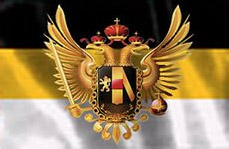 The tricolor of Peter the Great always existed in Russia in its original form. Only in the 18th century did the heirs of the first Russian emperor try to change the shape of the national flag. They wanted to fix on the tricolor the colors of the Russian coat of arms: the black double-headed eagle with the red coat of arms of Moscow on a gold background. But Alexander the Third restored the old color scheme.
The tricolor of Peter the Great always existed in Russia in its original form. Only in the 18th century did the heirs of the first Russian emperor try to change the shape of the national flag. They wanted to fix on the tricolor the colors of the Russian coat of arms: the black double-headed eagle with the red coat of arms of Moscow on a gold background. But Alexander the Third restored the old color scheme.
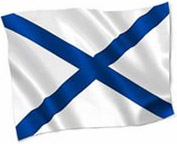 Peter the Great belongs and the honor of creating the naval flag of Russia. Work on it stood eight options. The last (eighth) and final version was described by Peter as follows: “The flag is white, there is a blue St. Andrew’s cross across it, which Russia baptized this saint”. As such, the St. Andrew’s flag existed in the Russian fleet until November 1917, when it was replaced with a red Soviet flag. From July 26, 1992, the St. Andrew’s flag was restored in the Russian fleet.
Peter the Great belongs and the honor of creating the naval flag of Russia. Work on it stood eight options. The last (eighth) and final version was described by Peter as follows: “The flag is white, there is a blue St. Andrew’s cross across it, which Russia baptized this saint”. As such, the St. Andrew’s flag existed in the Russian fleet until November 1917, when it was replaced with a red Soviet flag. From July 26, 1992, the St. Andrew’s flag was restored in the Russian fleet.
In different periods, St. Andrew’s flag bore various names:
- from 1720 to 1797 - First Admiral's flag;
- from 1799 to 1865 - Flag of the Elder Admiral;
- from 1865 to 1917 - Stern flag of military vessels;
- from 1992 to the present - Military nautical flag Russia.
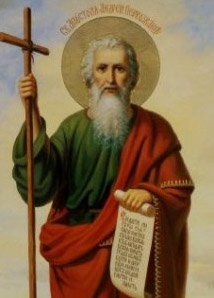 St. Andrew's naval flag Russia got its name by the name of the greatest Russian saint Andrew the First Called. Apostle Andrew He was one of the disciples of Jesus Christ and brother of the Apostle Peter. He became the first disciple of the Savior, for which he was named The first-called.
St. Andrew's naval flag Russia got its name by the name of the greatest Russian saint Andrew the First Called. Apostle Andrew He was one of the disciples of Jesus Christ and brother of the Apostle Peter. He became the first disciple of the Savior, for which he was named The first-called.
Even in his youth, Andrew decided to devote himself to serving God. He became the closest follower of John the Baptist, who pointed the future apostle to Jesus Christ coming to them: "Behold the Lamb of God." Leaving the Baptist, Andrew followed Christ and brought his brother to him.
Until the last day of Christ’s earthly journey, Andrew followed him, and after the death of the Savior on the cross, he witnessed his resurrection and ascension. Fifty days after that, in Jerusalem, the apostles, consecrated by heavenly fire, received the gift of prophesying, healing people, and bringing the light of Christianity to the nations of the world.
The twelve disciples of Jesus Christ divided among themselves the countries in which everyone had to preach a new religion. The territory of South and Eastern Europe, as well as the land of Scythia, fell by lot to St. Andrew. The first field of his apostolic ministry was the Black Sea coast.
Persecuted everywhere by the pagan authorities, he reached the Greek city of Byzantium. Here, in the future capital of Eastern Christianity, the Apostle was the first to establish the Orthodox Church and to prepare the priests, "so that they would teach the people."
Arriving after that in Korsun, Andrei learned that the mouth of the Dnieper, the great Slavic river, along which the Apostle had risen to the lands of the Eastern Slavs, is located nearby. On the Kiev hills, addressing his disciples, he said: “Believe me, God's grace will shine on these mountains; the great city will stand here, and the Lord will raise there many churches and enlighten the entire Slavic land with holy baptism. ” At the same time, at the request of Andrew, a cross was put over the Dnieper, in the place of which Kiev later emerged - the capital of the Old Russian state.
In Greece, Andrew was captured by the soldiers of Proconsul Virin, tortured and crucified in 70 on an oblique cross. Later, the Orthodox Cathedral of St. Andrew the First-Called was erected on this site. Today, the Apostle Andrew is revered by the founder and heavenly patron of the Constantinople Orthodox Church.
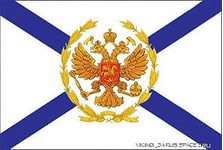 In Russia, the cult of Andrew the First Called became widespread in the 1080s, during the reign of the sons of Yaroslav the Wise. In 1068 the first Orthodox church was built in Kiev in honor of the Apostle, who brought the Orthodox faith to the Slavic lands. And after six centuries, in 1698, Tsar Peter the Great established the St. Andrew’s flag on the Russian navy and established Russia's highest military award - Order of St. Andrew the First Called. In 1998, both the flag and the order were revived in our country.
In Russia, the cult of Andrew the First Called became widespread in the 1080s, during the reign of the sons of Yaroslav the Wise. In 1068 the first Orthodox church was built in Kiev in honor of the Apostle, who brought the Orthodox faith to the Slavic lands. And after six centuries, in 1698, Tsar Peter the Great established the St. Andrew’s flag on the Russian navy and established Russia's highest military award - Order of St. Andrew the First Called. In 1998, both the flag and the order were revived in our country.
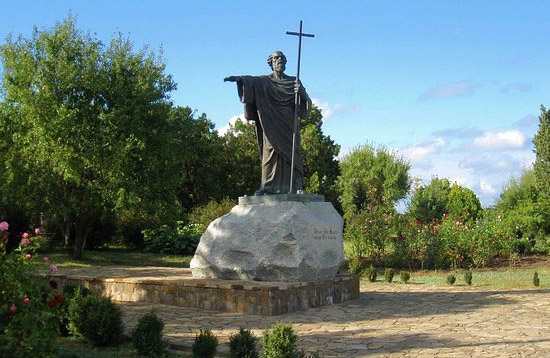
Monument to Andrew the First-Called in Chersonesos.
PART FIVE
Flags of Russia 18-19 century.
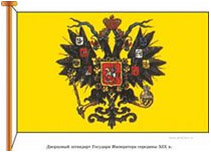 After the death of the king-converter in the color range of Russian symbols, as already mentioned, the role of gold and black shades intensified. Peter the Third introduced black hat bows with yellow stripes on the edges of the army hats, and to the coronation of Elizabeth Petrovna (1762) a new State banner was created: a yellow cloth with an image on both sides of a black double-headed eagle surrounded by 31 emblems of the lands included in the empire.
After the death of the king-converter in the color range of Russian symbols, as already mentioned, the role of gold and black shades intensified. Peter the Third introduced black hat bows with yellow stripes on the edges of the army hats, and to the coronation of Elizabeth Petrovna (1762) a new State banner was created: a yellow cloth with an image on both sides of a black double-headed eagle surrounded by 31 emblems of the lands included in the empire.
Catherine II also continued to experiment with Russian state regalia. She approved a slightly modified version of the Order of St. George. At her disposal, the order was decorated with a black and orange ribbon, which symbolized "gunpowder and fire."
In 1819, the first battalion black-white-yellow flag appeared in Moscow, but the Petrovsky tricolor still remained the main symbol of Russia. Its colors became a model for creating state flags of the Balkan Slavs - Serbs, Croats, Slovaks, Czechs. Only the Bulgarians replaced the blue strip on their flag with a green color.
 To the coronation of Alexander the Second (1856) court heraldist B.V. Koene created a new version of the parade banner. It was made of black, yellow and white shades. In the center, a black Russian eagle with a white George the Victorious on his chest was painted. Such flags and banners did not last long in Russia - from 1858 to 1883, when Alexander the Third finally made the Russian national banner the Petrovsky white-red-blue tricolor.
To the coronation of Alexander the Second (1856) court heraldist B.V. Koene created a new version of the parade banner. It was made of black, yellow and white shades. In the center, a black Russian eagle with a white George the Victorious on his chest was painted. Such flags and banners did not last long in Russia - from 1858 to 1883, when Alexander the Third finally made the Russian national banner the Petrovsky white-red-blue tricolor.
On the eve of the coronation, April 28, 1883, Alexander the Third issued the Highest Order “On Flags to Decorate Buildings in Celebratory Occasions”, according to which, on holidays, the use of foreign flags was forbidden and a single sample of the National Banner of Russia was introduced - a white-blue-red cloth .
PART SIX
State flag of the USSR
 In February 1917, when Emperor Nicholas II abdicated the throne, Russia was proclaimed a bourgeois republic. However, the Legal Meeting of the Provisional Government decided to leave the white-blue-red cloth as the national flag. The Petrovsky tricolor was considered a symbol of Russia until the October Socialist Revolution (October 1917), after which power in the country passed to the Bolsheviks.
In February 1917, when Emperor Nicholas II abdicated the throne, Russia was proclaimed a bourgeois republic. However, the Legal Meeting of the Provisional Government decided to leave the white-blue-red cloth as the national flag. The Petrovsky tricolor was considered a symbol of Russia until the October Socialist Revolution (October 1917), after which power in the country passed to the Bolsheviks.
In connection with the fact that the white-blue-red flag during the Civil War was actively used by supporters of the restoration of the monarchy, the Council of People's Commissars decided: “The red flag with the inscription“ Russian Soviet Socialist Republic ”is being set with the flag of the Russian Republic. In the summer of 1918, a new sample of the flag was approved by the Soviet government and universally introduced as a new symbol of state power.
 On December 30, 1922, the RSFSR merged with the Ukrainian, Belarusian and Transcaucasian socialist republics into a union state - Union of Soviet Socialist Republics. After that, a new sample of the National Flag was adopted: "A red or scarlet rectangular panel with an image in the upper left corner of the Sickle and Hammer, and above them - the red five-pointed Star."
On December 30, 1922, the RSFSR merged with the Ukrainian, Belarusian and Transcaucasian socialist republics into a union state - Union of Soviet Socialist Republics. After that, a new sample of the National Flag was adopted: "A red or scarlet rectangular panel with an image in the upper left corner of the Sickle and Hammer, and above them - the red five-pointed Star."
 But in practice, the most common version of the national flag of the USSR until 1955 remained a red rectangular panel without any inscriptions. Below him, the Red Army fought on the fronts of the Civil War (1918-1920), under it the Soviet soldiers met and victoriously ended the Great Patriotic War (1941-1945).
But in practice, the most common version of the national flag of the USSR until 1955 remained a red rectangular panel without any inscriptions. Below him, the Red Army fought on the fronts of the Civil War (1918-1920), under it the Soviet soldiers met and victoriously ended the Great Patriotic War (1941-1945).
White Guard units that went over to the side of the fascist invaders continued to use the white-blue-red tricolor and St. Andrew’s naval flag in the ROA units, so these symbols were not recognized until 1991 in the Soviet Union.
In years Adjustment (1985-1990) for the first time after a seventy-year break, the Petrovsky state flag began to appear at demonstrations of the democratic movement. It was first raised on October 7, 1988 over the Leningrad Lokomotiv stadium, where the rally of the Democratic Union of Russia was held. Even earlier, since 1987, numerous national-patriotic movements of Russia used it, for example, the “Memory” society.
In 1989, the historical patriotic movement "Russian Banner" took the initiative to officially recognize the white-blue-red tricolor as the official state flag of democratic Russia. A wide campaign has been launched to collect signatures in support of this requirement.
At the same time, other versions of the ceremonial banners of the Russian Empire began to be used in the country: the black-white-gold tricolor (supporters of monarchical power), the blue-red-green flag (the Rossi party), etc. Disputes about the new state symbol of Russia continued.
In the match for the title of World Chess Champion (1990), Garry Kasparov, the official representative of the USSR, played under the white-blue-red flag - the symbol of a new democratic Russia. His opponent, Anatoly Karpov, played under the red flag of the USSR. At the same time, red flags of the RSFSR continued to be used in street processions. For example, on February 23, 1992, at a rally in honor of the Day of the Soviet Army and Naval Flag, which gathered about 10 thousand people in the center of Moscow, its participants carried red banners of the USSR and the RSFSR.
However, in March 1990, the Constitutional Commission began working in the country, which introduced the draft of the new state flag of Russia: “A three-colored rectangular panel with equal horizontal stripes: the upper one is white, the middle one is blue, the lower one is scarlet.”
PART SEVEN
National flag of the Russian Federation
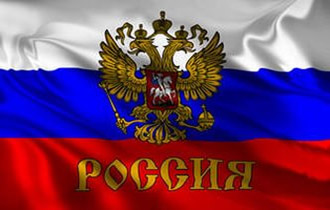
In the course of an acute political struggle, the Committee for the Design of New State Symbols, created under the USSR Council of Ministers, submitted recommendations to the Supreme Soviet of the Republic on the restoration of the white-blue-red banner. The final decision was postponed until the completion of the elections for the first president of the country, which were to be held in 1991.
In the summer of 1991, the Petrovsky tricolor was widely used by democratic forces opposing the Emergency Committee during the August putsch. After the elimination of the coup, August 22, 1991, the decision of the Supreme Soviet of the RSFSR historical flag Russia was officially recognized by the new state symbol of the country: “The Supreme Soviet of the RSFSR decided that, before approval by the special law of the new state symbolism of the Russian Federation, consider the historical flag of Russia - a cloth of equally horizontal white, azure and scarlet bands - the official National Flag of the Russian Federation”.
And already on November 1, 1991, the Fifth Congress of People's Deputies of the RSFSR white-azure-scarlet flag was legally approved by the state flag of the country. 750 deputies out of 865 who participated in the voting voted for his approval. Shortly thereafter, the name of the Russian republic “RSFSR” was also legislatively changed to “Russian Federation (Russia)”.
During the development of the new Constitution of the Russian Federation, the Constitutional Commission received a proposal to change the colors of the two last bands of the flag to blue and red. This was explained by the fact that the azure and scarlet color in the state symbolism of Russia had never been used before.
On the eve of the adoption of the new Constitution of the Russian Federation, which took place on December 12, 1993, President B.N. Yeltsin signed the Decree “On the State Flag of the Russian Federation”.
 At the same time, the Victory Banner was preserved in the country, under which the Soviet Army in 1945 completed the defeat of Nazi Germany. According to the Federal Law of the Russian Federation of May 7, 2007, the Victory Banner on May 9 may be hung on buildings, raised on masts and flagpoles along with the State flag of the Russian Federation.
At the same time, the Victory Banner was preserved in the country, under which the Soviet Army in 1945 completed the defeat of Nazi Germany. According to the Federal Law of the Russian Federation of May 7, 2007, the Victory Banner on May 9 may be hung on buildings, raised on masts and flagpoles along with the State flag of the Russian Federation.
Every year on August 22, the Day of the State Flag of the Russian Federation is celebrated in our country. The largest flag of Russia was raised in August 2011 in the Chechen Republic - on a mountain height of 300 meters. It had a cloth area of 150 square meters. The height of its flagpole was 70 meters.
On July 7, 2013 in Vladivostok, almost 30 thousand citizens lined up on the bridge across the Golden Horn Bay with red, white and blue flags in their hands. They recreated the 707-meter flag of Russia over the bay. This is the largest "living" flag of Russia hit the "Guinness Book".
The flag as a symbol of the Russian state has been known for a long time. The first mention of it dates back to 1668. Since those times, the Russian flag has changed its appearance several times. However now russian tricolor - this is the first flag of the Russian state.
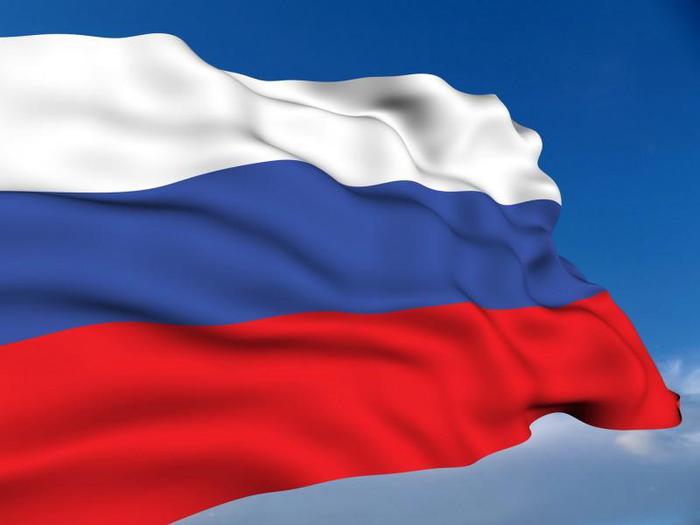 Under Tsar Alexei Mikhailovichthe construction of the first ships began, whose task was to protect trade caravans. When launching the first ship, the question arose under which flag to go to him. The national flag in Russia until this time was not. Having carefully studied all existing flags, the king commanded, be the Russian flag white-blue-red.
Under Tsar Alexei Mikhailovichthe construction of the first ships began, whose task was to protect trade caravans. When launching the first ship, the question arose under which flag to go to him. The national flag in Russia until this time was not. Having carefully studied all existing flags, the king commanded, be the Russian flag white-blue-red.
Peter I somewhat changed the law on the flag, having commanded only merchant ships to walk under the tricolor, the warships of Russia had to walk under the flag of St. Andrew — a white cloth with an azure cross.
Imperka - the flag of the Russian Empire
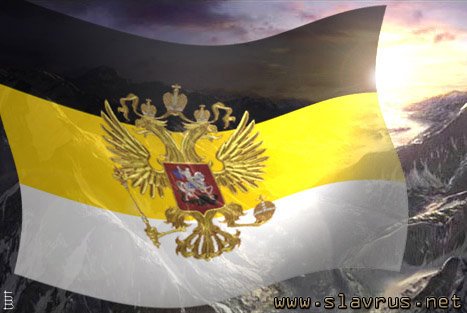 After the appearance of the flag in the country as a symbol of the state, each Russian ruler considered it his duty to change the state symbols. The most serious changes have been Russian symbols in 1858 under Tsar Alexander II. By decree of the emperor was established the third Russian flag. It was a black-yellow-white, "monarchic", tricolor, which was supposed to raise above government and administrative institutions. This flag did not last long, it was abolished in 1883, when King Alexander III took the throne. His decree was finally approved by the national flag of the white-blue-red tricolor, which was ordered to be raised above the buildings during the days of state celebrations.
After the appearance of the flag in the country as a symbol of the state, each Russian ruler considered it his duty to change the state symbols. The most serious changes have been Russian symbols in 1858 under Tsar Alexander II. By decree of the emperor was established the third Russian flag. It was a black-yellow-white, "monarchic", tricolor, which was supposed to raise above government and administrative institutions. This flag did not last long, it was abolished in 1883, when King Alexander III took the throne. His decree was finally approved by the national flag of the white-blue-red tricolor, which was ordered to be raised above the buildings during the days of state celebrations.
 The flagpole service in Russia offers flags for rooms and offices, for exhibitions and receptions. If you have your own office, purchase office flag. This will give your office the most prestigious look, readiness and opportunity to arrange meetings and meetings at the highest level.
The flagpole service in Russia offers flags for rooms and offices, for exhibitions and receptions. If you have your own office, purchase office flag. This will give your office the most prestigious look, readiness and opportunity to arrange meetings and meetings at the highest level.
The last Russian emperor Nicholas II, at his accession to the throne, legalized the three colors of the Russian flag and their meaning. Red color meant state power, blue - was a symbol of the Mother of God, patroness of Russia, white was a symbol of independence and freedom. Also, these colors symbolized the unity of White, Little and Great Russia.
USSR flag
 After the October Revolution, in 1818, Yakov Sverdlov proposed as a national flag red rod. Under this banner, Russia has passed the most difficult trials in its history. But under this flag they went into battle, defending our Motherland from fascism. The red cloth became the banner of Victory, which hoisted over the defeated Reichstag.
After the October Revolution, in 1818, Yakov Sverdlov proposed as a national flag red rod. Under this banner, Russia has passed the most difficult trials in its history. But under this flag they went into battle, defending our Motherland from fascism. The red cloth became the banner of Victory, which hoisted over the defeated Reichstag.
After the restoration of the new state - the Russian Federation, the country once again returned to the historic white-blue-red tricolor. By the decree of the first President of Russia B. N. Yeltsin, the Day of the State Flag was established, which is celebrated since August 22, 1994.
.
The last Law on the State Flag was signed in 2000 by V. V. Putin. This law states that the State Flag of Russia is a rectangular panel, which consists of three equal-sized bands of white, blue and red, where the ratio of width and length is 2: 3. The white color in this flag denotes purity and perfection, blue is the symbol of loyalty and faith, and red is energy, strength and blood shed for Russia.
There is also a series of intermediate flags. Not all flags are displayed in this article. According to some sources, priority in creating the first flag of Russia is given to Peter I
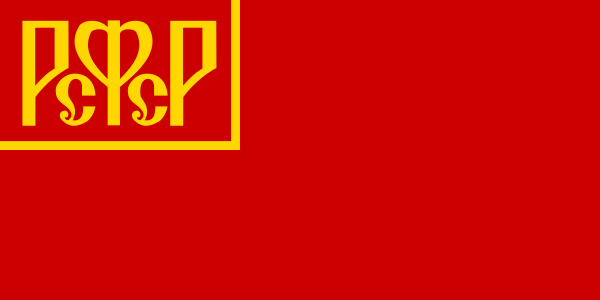
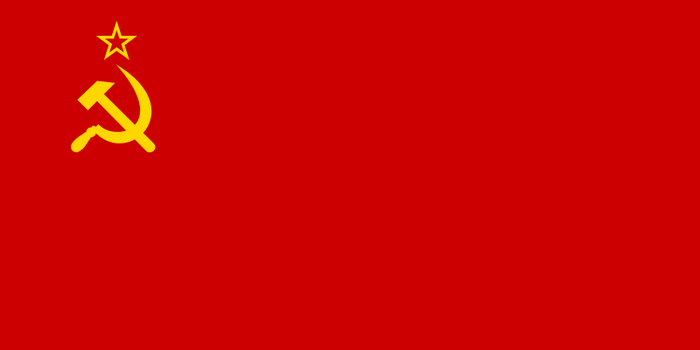
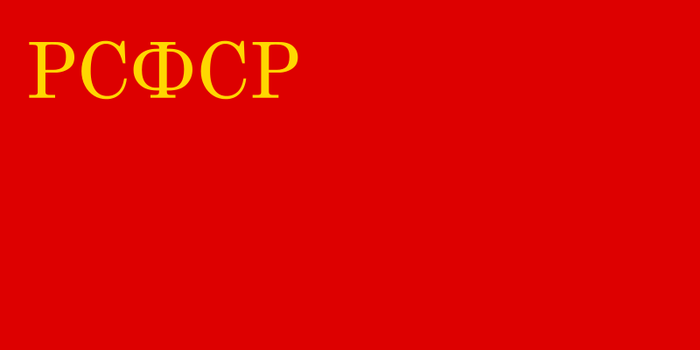
Battle banners and banners existed in Russia in antiquity
In ancient times, the word “flag” was used instead of the words “flag” and “banner”. The expression "to put a banner" meant the formation of a squad for the battle. Banner "knights" in order of battle and noted the core of the troops. In his defense put styagovnikov heroes.
Flags and banners of Russia Empire and Russia

The banner was judged on the course of the battle. Banner "prostrate like clouds" means the battle is going well. The fall of the banner spoke of the plight of the troops, that the enemies "reached the banner, and podsekosha." Our records are extremely laconic and stingy for details. Nevertheless, they even noted the loss of a part of the banner and the death of the clerk: "The bangs of the clerk were merged," and "The cords of our sweat." Noteworthy is also the origin of the word "Banner."
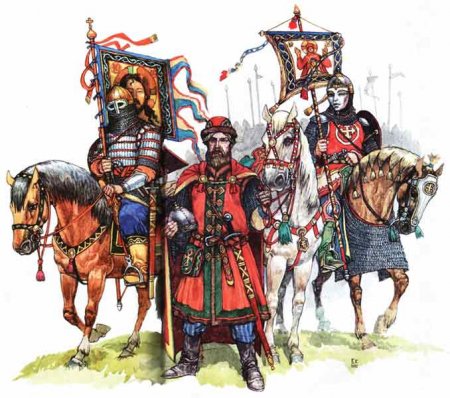
Images of Orthodox shrines were called "Signs." Once on the banners began to portray of St. George and other holy faces, they turned into "signs", and then into "banners." A single national flag in dopetrovskaya Rus did not exist. From ancient times on the banners of the great princes depicted the saints, the faces of Christ and the Virgin.
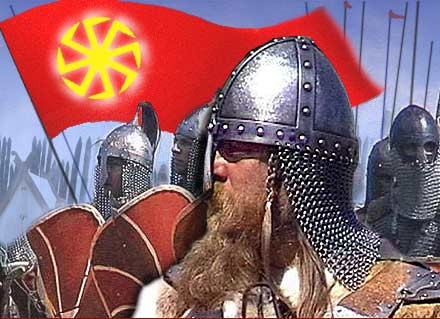
For many centuries, the Russian army was overshadowed by red banners. In the 10th century, the knights of Svyatoslav the Great fought under the red banners. In one of the ancient manuscripts preserved their images. The cloths of the banners were wedge-shaped, and the tops were in the form of a spear with a crossbar, that is, in the form of a cross.

Three centuries later, the army of Dmitry Donskoy went against the hordes of Mamai. On the Kulikovo field, a huge red banner with the image of the image of the Divine Savior was flying over the Russian army.
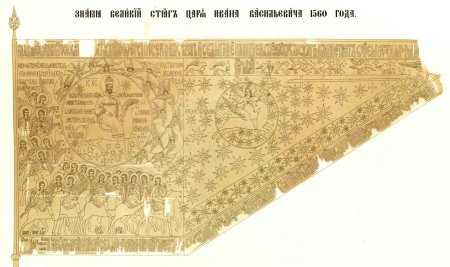
In fact, the regimental Big Banner of Ivan the Terrible was of the same color and with the same image. In 1552, the Russian regiments went under him to the victorious assault of Kazan. The chronicle entry about the siege of Kazan by Ivan the Terrible (1552) states: “the sovereign Herugwy ordered the deployment of the Christian, that is, the banner, the image of our Lord Jesus Christ, without hands, and the life-giving cross erected by his grandfather, our great sovereign, Prince Dmitri on the Don. "
The banner of Ivan the Terrible and a half century was accompanied by the Russian army. Under Tsarina Sofia Alekseevna, it was in the Crimean campaigns, and under Peter I - in the Azov campaign and the war with the Swedes.
The Facial Chronicle contains the image of the banner of Ivan the Terrible in the Kazan campaign - the forked white with the image of the Savior and the eight-pointed cross over it. According to others, the banner (probably regimental) was red with the image of the Savior. A copy of this banner, many times restored, is still kept in the Kremlin Armory.

The so-called “Great Banner” of Ivan the Terrible is well known. This panel in the form of a trapezoid (with a slope). At the flagpole on the azure field, St. Michael is depicted on a horse. On the slope of the "sugar" color depicts Christ. The banner has a cowberry-colored border, and an additional poppy-colored border at the escarpment.
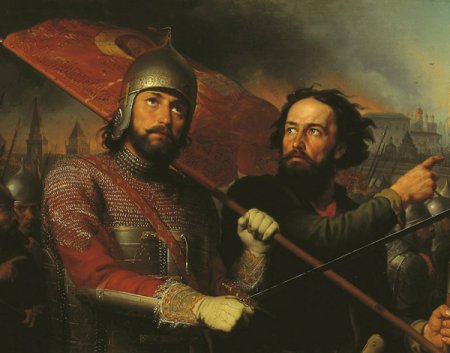
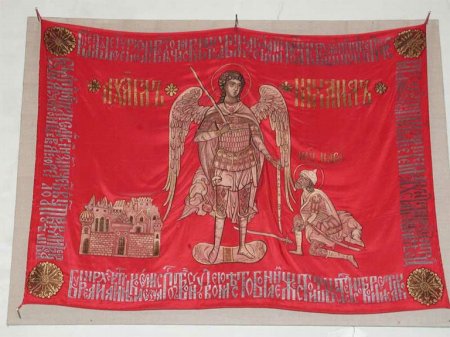
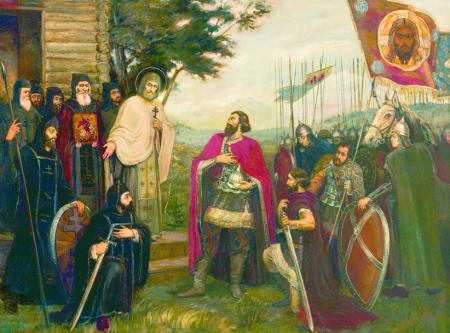
In 1612, the banner of Dmitry Pozharsky fluttered over the militia that had left Nizhny Novgorod for Moscow. It was crimson in color and on one side bore the image of the Lord Almighty, and on the other the archangel Michael. The people's militia led by Kozma Minin and Dmitry Pozharsky put an end to the Time of Troubles, liberation from the Polish-Lithuanian yoke and liberated Moscow from invaders. The enemies and traitors of Russia were expelled, and Russian statehood was restored. The banner of Prince Pozharsky at the time of peace was placed in the church and revered along with the icons. In the terrible year of the Napoleonic invasion, an exact copy was made from the flag of Pozharsky and handed over to the Nizhny Novgorod militia.
Religious subjects were depicted on other royal banners. On the scarlet banner of Alexei Mikhailovich, for example, depicted the face of the Savior.
Russian flag
Flag - a cloth of a certain color or several colors attached to a pole or cord, often with an emblem, the official symbol of state power, personifies the sovereignty of the state. The description of the flag is usually fixed in the constitution.
The flag of Russia and the state flag of the Russian Federation, its official state symbol (along with the coat of arms and anthem). The Russian flag is a rectangular panel of three equally-sized horizontal stripes: the top is white, the middle is blue, and the bottom is red. The ratio of the width of the flag to its length is 2: 3.
The first Russian flag
Until the XVII century, Russia did not have a single national flag. The first mention of the Russian flag appeared in 1668 during the reign of Alexei Mikhailovich, father of Peter I, when trade with foreign countries began to develop rapidly. Tsar Alexei Mikhailovich gave the order: "... build ships to protect trade caravans." In the small village of Dedinovo, on the banks of the Oka River, hastily assembled artisans from nearby villages, and the ship Eagle was soon built. He was appointed captain Butler, who, as noted in many historical documents, was distinguished for his pedantic and stern temper. He first addressed the sovereign with a question: under what flag will the ship come out? “... Of which state the ship of that state is also a banner,” Butler did not fail to notice. But the state banner itself was not yet.
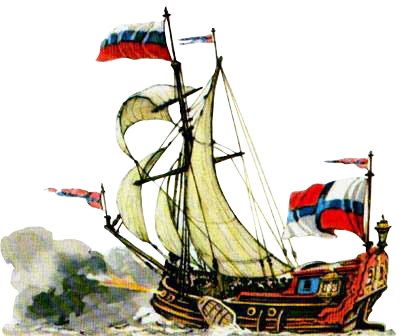
The king, having thoroughly studied the colors of the flags of different countries, stopped at white - blue - red. And over the Volga-Caspian flotilla began to fly this flag. Status flag changed Peter I. On January 20, 1705, the sovereign commanded only "... on merchant ships to be the banner, on the model of what is painted, sent under this of the Great Sovereign by decree." Peter I personally painted the sample and determined the order of the horizontal stripes on the flag. Historians believe that the model served as the Dutch flag, consisting of three horizontal stripes of the same colors. He was one of the first liberation flags in Europe; under its banner was the struggle for the independence of the Netherlands.
If the situation with the colors of the Russian flag is rather clear, then there are different opinions about its design:
The author of Essays on Russian Maritime History, F.F. Veselago, believes that “from the colors of the materials used on the flag of the ship Oryol, and from the fact that when they were armed with the main stewards were the Dutch, it is likely that the then flag in imitation of the Dutch consisted of three horizontal bands: white, blue and red. " This is confirmed by the fact that Alexey Mikhailovich ordered his son, Peter (the future Russian emperor Peter I the Great), to sew three-strip white-blue-red flags.
Another well-known fleet historian, P. I. Belavenets, disagrees with these arguments. In his work “The Colors of the Russian State National Flag,” he refers to the famous engraving “The Taking of the Fortress of Azov. 1696 ”by the Dutch artist A. Schonebeck. The flags of the Russian fleet on it look like cloths, divided by the cross into equal parts. It should, however, be noted that the capture of Azov dates back to the times of Peter I; the first documentary mention of the white-blue-red flag, as close as possible to the modern flag of Russia, dates back to this time.
On August 6, 1693, during the sailing of Peter I on the 12-gun yacht “Saint Peter” in the White Sea with a detachment of warships built in Arkhangelsk, the flag of the Tsar of Moscow, the flag consisting Of the three horizontal bands of white, blue and red, with a golden double-headed eagle in the middle. The flag, similar to the modern Russian flag, was used as the maritime flag of Russia. Considering the fact that in the ground forces each regiment had its own banner, a single maritime flag adopted by Peter was the de facto national flag of Russia.

In 1699-1700 Peter I introduced a new standard, and developed new versions of the naval flag. On January 20, 1705, Peter I issued a decree according to which a “white-blue-red flag should be raised“ on all sorts of merchant ships ”. The three-strip flag was also used on warships until 1712, when the St. Andrew’s flag was approved as a naval flag. The white-blue-red flag becomes a commercial flag (that is, the flag of civilian ships).
The official interpretation of the colors of the flag was as follows: white - the color of freedom, blue - the color of the Virgin, red color symbolizes derzhavnost. On the other hand, these are the colors of White, Little and Great Russia.
Despite the fact that Peter I developed a huge number of flags during his life (various versions of the flag of St. Andrew, standards of the Tsar of Moscow and the Emperor of All-Russia, versions of the Guys, etc.), the national flag of the Russian Empire was never installed.
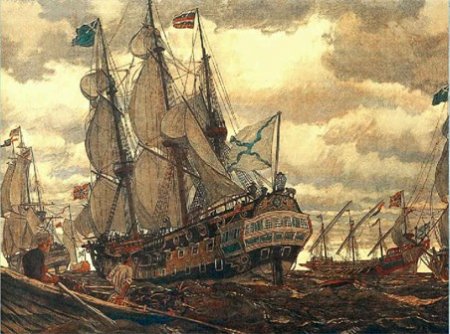
For almost a century and a half, Peter's successors continued this “tradition”: despite the widespread use of the Russian white-blue-red tricolor in everyday life, its status as the flag of the Russian Empire was not legally established.
In 1858, in the reign of Emperor Alexander II, the chairman of the heraldic chamber of the Russian Empire, Baron Kene, drew the attention of the sovereign to the fact that the colors of the national flag of Russia do not coincide with the colors of the state emblem (which went against the rules of German heraldry). Despite the fact that in reality the colors of the Russian flag corresponded to the colors of the central, most ancient image of the state emblem of the empire, namely the emblem of Moscow, Baron Kene managed to convince the emperor of the need to create a new flag.
The flag of the Austrian Empire (1804-1867), the dynastic flag of the Habsburgs. It is possible that the decision to adopt the black-yellow-white flag as the national flag of the Russian Empire was influenced by the fact that another empire of that time - the Austrian - used a similar flag, which was a black-and-yellow cloth (colors of the Holy Roman Empire of the German Nation XV -XIX centuries).

It is possible that the decision to adopt the black-yellow-white flag as the national flag of the Russian Empire was influenced by the fact that another empire of that time - the Austrian - used a similar flag, which was a black-and-yellow cloth (colors of the Holy Roman Empire of the German Nation XV -XIX centuries).
By decree of Alexander II of June 11, 1858, a black-yellow-white flag flag was introduced.
A description of the highest approved pattern of the arrangement of the Empire’s official colors on banners, flags, and other items used for decorations on special occasions. The arrangement of these colors is horizontal, the upper band is black, the middle one is yellow (or gold), and the bottom one is white (or silver). The first stripes correspond to the black state eagle in the yellow field, and the cockade of these two colors was founded by Emperor Paul I, while the banners and other decorations of these flowers were used during the reign of Empress Anna Ioannovna. The lower band is white or silver corresponds to the cockade of Peter the Great and Empress Catherine II; the emperor Alexander I, after the capture of Paris in 1814, connected the correct coat of arms with the ancient Peter the Great, which corresponds to a white or silver horseman (St. George) in the Moscow coat of arms. "
However, the Russian society did not accept this new symbol of state power: in the minds of Russians, black and yellow colors were associated with Austria and the Hapsburg home ruling there. In the empire, in parallel, there were two flags: black-yellow-white - the national “de jure” and white-blue-red - the national “de facto”, with the preference of the population everywhere given to the latter.
Emperor Alexander III, known for his Russophile sentiments, drew attention to the contrast in Moscow during the coronation: the Kremlin was decorated and the whole procession was dressed in white-yellow-black, and in the city white-blue-red colors prevailed. A commission of authorities was appointed under the chairmanship of the Adjutant General Admiral K. N. Posiet. The Commission made the following decision:
“The white-blue-red flag, established by Emperor Peter the Great, has almost 200 years ago. Heraldic data is also noticed in it: the Moscow coat of arms depicts a white horseman in a blue raincoat on a red field. These colors are confirmed by the flags in the navy: the 1st line is indicated by red, the 2nd by blue and the 3rd by the white flag with St. Andrew's cross in the roof. The counter- and vice-admiral flags, respectively, have red and blue stripes, and finally, the guis is made up of colors: white, blue, and red. On the other hand, white-yellow-black colors have neither historical nor heraldic bases behind them. ”
Based on the decision of the commission of Admiral Posyet, the national flag was the highest approved white-blue-red.
On April 28, 1883 (May 7, 1883, this decision was included in the Assembly of the Russian Empire) Alexander III issued the “Authority on Flags to Decorate Buildings for Special Occasions”, requiring the use of an exclusively white-blue-red flag. From now on, black-yellow-white was considered the dynastic flag of the reigning house of the Romanovs. According to other data, contrary to this statement, the white-blue-red flag is the highest approved by Emperor Alexander III only “for commercial courts”.
The last Russian emperor Nicholas II in 1896 finally secured the status of the only national flag of the Russian Empire for the white-blue-red flag.
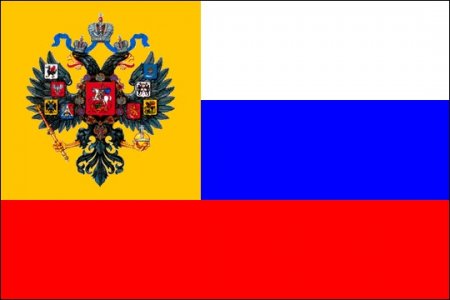
With the beginning of the First World War in 1914, an additional imperial flag was introduced by the Ministry of Foreign Affairs to raise patriotism of the population by a special circular of the Ministry of Foreign Affairs “for use in private life”. It differed from the national flag of the empire in a yellow square with a black double-headed eagle (composition corresponding to the emperor's palace standard). The eagle was depicted without title emblems on the wings, the square overlapped the white and about a quarter of the blue flag strip. However, this flag did not receive distribution; contrary to popular misconception, it was never the national flag of the Russian Empire. The new flag was not introduced as mandatory, its use is only "allowed". Symbols of the flag emphasized the king's unity with the people.
The colors of the white-blue-red flag of Russia (the so-called Pan-Slavic colors) were used to create flags by many Slavic states and peoples - Czechoslovakia (now the flag of the Czech Republic), Slovakia, Slovenia, Croatia, Serbia, Montenegro (with blue replaced by blue) Bulgaria (with the replacement of blue to green), Puddle Serbs. In addition, the Slavic flag is also painted in the colors of the Russian flag.
Flag of the Russian Republic
After the February Revolution of 1917, Emperor Nicholas II abdicated the throne in favor of his brother, Grand Duke Mikhail Alexandrovich, who, in turn, transferred power to the Provisional Government. On September 1 (14), 1917, Russia was proclaimed a democratic republic.
During the revolution, the red flag was widely used, but the Legal Counsel, held on April 25, 1917, proposed to leave the white-blue-red flag as the national flag. At a meeting of the Provisional Government, held on May 6, 1917, the issue of the state emblem and national flag was postponed until "the resolution of the Constituent Assembly". The white-blue-red flag continued to be the state symbol of Russia until April 1918.
Flag of Soviet Russia
After the October Revolution, the role of the national flag in the first months of the Soviet government was carried out by a rectangular red cloth that did not have any inscriptions or emblems. However, this kind of national flag was not established by any regulatory documents (the official name adopted by the Provisional Government - the Russian Republic, and the white-blue-red flag - were legally preserved).
On April 8, 1918, the issue of the national flag was discussed at a meeting of the Council of People's Commissars. In the resolution of the Council of People's Commissars it was proposed to the All-Russian Central Executive Committee to declare the red flag with the letters “P. V.S.S. "(that is, with the abbreviation of the motto" Proletarians of all countries, unite! ").

However, this proposal was not accepted. By the decree of the All-Russian Central Executive Committee of April 13, 1918, the official flag of the RSFSR proclaimed the red flag with the inscription: “Russian Socialist Federative Soviet Republic”. The text of the decree did not contain any clarifications regarding the color, size and location of the inscription, the ratio of the width and length of the cloth.
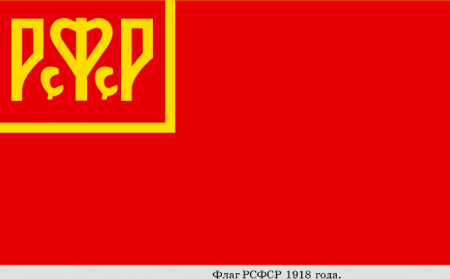
On July 10, 1918, the 5th All-Russian Congress of Soviets approved the first Constitution of the RSFSR, which was published on July 19 of the same year. Article 90 of the Constitution contained a description: “The merchant, sea, and military flag of the RSFRS consists of a panel of red (scarlet) color, in the left corner of which, near the pole, are placed the gold letters above: R. С F. S. P. R. or the inscription: Russian Socialist Federal Republic. The Constitution of the RSFSR of 1937 also confirmed the use of this flag as a state flag.
Trade, Maritime and Military Flag

In February 1947, the Presidium of the Supreme Soviet of the USSR adopted a resolution recommending to the Union republics to adopt new state flags based on the flag of the USSR. In 1954, a new type of flag of the RSFSR was installed: a red rectangular panel with a light blue stripe at the flagpole in the entire width of the flag, which is one-eighth of the flag's length. In the upper left corner of the red cloth depicted a golden sickle and hammer, and above them a red five-pointed star, framed by a golden border. The ratio of the width of the flag to its length - 1: 2. The flag was introduced by the Decree of the Presidium of the Supreme Soviet of the RSFSR of January 9, 1954, then approved on December 23, 1955 by the Decree of the Presidium of the Supreme Soviet of the RSFSR on the Regulations on the State Flag of the RSFSR, then confirmed by article 181 of the RSFSR Constitution of 1978. On January 22, 1981, by the Decree of the Presidium of the Supreme Soviet of the RSFSR, the Flag Regulations also clarified that no star, hammer and sickle are depicted on the reverse side of the cloth.
The use of the flag of Tsarist Russia in Soviet times
During the Civil War, the white-blue-red flag of Russia was used by the White movement, and at the end of it - by immigrant organizations outside Russia.
During the Great Patriotic War of 1941-1945, the historical flag of Russia, along with the St. Andrew's flag, was used by Russian military formations that fought on the side of the Third Reich: ROA, RONA, Cossack Stan, 1st Russian National Army (1st RNA).
Children about the flag of Russia:
Flag of the Russian Federation
In the late 1980s, the historical flag of Russia became one of the symbols of the movement for reform and against the communist ideology. During the so-called “August putsch”, the Russian tricolor was widely used by the opposing forces of the State Emergency Committee. After the GKChP defeat, the white-blue-red flag was used by the RSFSR as a state one, however, this provision was legally fixed only on November 1, 1991. A rectangular cloth with equal horizontal stripes was set up with the RSFSR flag: the upper band was white, the middle one was azure and the bottom was scarlet . The ratio of the width of the flag to its length - 1: 2.
On December 25, 1991, the name of the state "RSFSR" was replaced by "Russian Federation (Russia)".
On December 11, 1993, the President of the Russian Federation B. N. Yeltsin signed Decree No. 2126 “On the State Flag of the Russian Federation”, which approved the Regulations on the National Flag of the Russian Federation and declared the Regulations on the National Flag of the RSFSR, approved by the Decree of the Presidium of the Supreme Council of the RSFSR, invalid. December 23, 1953. In Article 1 of the Statute on the State Flag of the Russian Federation, it was described as a rectangular panel of three equal horizontal stripes: the top is white, the middle is blue, and the bottom is red. The ratio of the width of the flag to its length - 2: 3.
The description of the national flag of the Russian Federation contained in the 1993 Regulations was repeated without changes in Article 1 of the Federal Constitutional Law of 25 December 2000 No. 1-FKZ “On the National Flag of the Russian Federation”. The law came into force on December 27, 2000.
January 1, 1999 introduced GOST R 51130-98 "Flag of the Russian Federation. General technical conditions.
Meaning of flag colors
There is no official interpretation of the colors of the Russian flag, but it is generally accepted that:
white symbolizes peace, purity, purity and perfection (or Freedom);
blue symbolizes constancy, faith and faithfulness (or the Virgin Mary);
red symbolizes energy, strength and blood, shed for the Fatherland (or Autocracy).
Day of the National Flag of the Russian Federation
The Day of the National Flag of the Russian Federation is a National holiday. It was established in 1994 by decree of the President of the Russian Federation.
This is one of the “youngest” holidays of modern Russia, it is dedicated to the revived flag of Russia - the “state tricolor”. National Flag Day is celebrated on August 22 and is not a day off. Only on this day everyone can freely hang a flag on his balcony.
Flag Day Celebration
Events for the celebration have a double motive: in Russia is not allowed the free use of state symbols.
2007 Saint Petersburg
In 2007, the Day of the State Flag of the Russian Federation was widely celebrated for the first time. The following holiday events have passed;
A midday shot from the Naryshkin bastion of the Peter and Paul Fortress, which was committed by Petersburgers of different generations.
- For the first time in the history of the fortress on the bastion, the state tricolor was solemnly raised.
- All participants of the holiday received ribbons, ties, flags with the state symbols of Russia.
Moscow
In Moscow, during the celebration of Flag Day, the largest tricolor was raised on the rowing canal - 380 square meters. m and weighing 25 kg.
Sochi
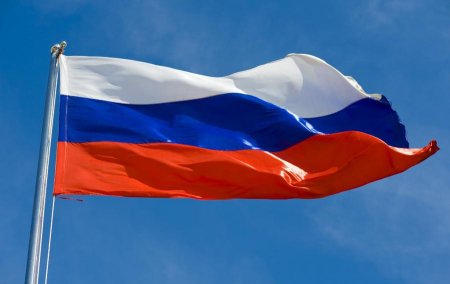
Above all in Russia raised the tricolor.
In contact with
- Historical flags of the states of 1700
- The role-playing game as the main type of games for preschoolers place in the structure of children's games
- Logic Tricks for Adults
- Medical Institute with budget places
- "Our Tanya cries out loud ..." in the interpretation of the great poets
- Photo of the American flag, the history of the stars and stripes of the state symbol of the United States
- Exercise "The Most Important"

 Live journal
Live journal Facebook
Facebook Twitter
Twitter